Contemporary Vietnamese Traditional Weddings The
traditional Vietnamese wedding is one of the most important ceremonies
in Vietnamese culture with influence from Confucian and Buddhist
ideologies. It is a significant day not only to the couple involved but
also for both families. Thus, it usually includes quite a few formal
ritual observances.
| Arranging the marriage
The first stage of marriage is usually when the young man will formally request the woman's hand in marriage.
The
actual request is traditionally made by the young man and the young
man's parents, or aunt and uncle, and a go-between
who go to meet the young woman's parents.
In Vietnamese families the eldest uncles control the family and must be consulted before marriage.
In our case, since we were in the
U.S. and Trang's family was in Vietnam, Greg formally asked for
permission to marry Trang directly from her father and all of her uncles via video
conference on Skype (which was definitely a first for them).
| 
|
|
| Greg's Ao Dai ( pronounced Ow Yai )
The
traditional attire for men in Vietnam is the Ao Dai, Greg's Ao Dai's
were both designed by Trang and custom made in Vietnam before we
arrived.
Greg's white ao dai features a red dragon which in Vietnam symbolizes
nobility and power, the gold ao dai symbolizes prosperity.
Trang also designed all of her own dresses.
Traditionally
the main color in a Vietnamese wedding is red, because red symbolizes
good luck in Vietnamese culture, but in western weddings the color red
is taboo because it is "the color of Satan", so Trang changed the color
of our wedding to her favorite color... pink. |  | 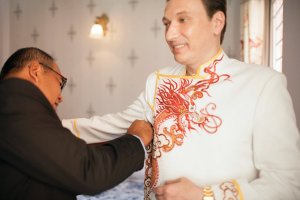 |  | The wedding day
On
the wedding day the groom's representative, in this case a long-time
friend of her fathers, arrives at the groom's house to help him prepare
to go to the bride's family home.
The groom's representative
arrives with several young men also dressed in
"Ao Dai's" for the procession to the bride's house, and
carrying traditional gifts for the bride's family. |
The Groom's Procession
The
groom, his representative and the young men carrying gifts leave the
groom's house and proceed to the bride's family home. In the old days
this procession was done by walking or by carriage to let everyone in
the town know that a wedding was taking place. Modern weddings use a car decorated with flowers.
The groom carries flowers to present to the bride. | 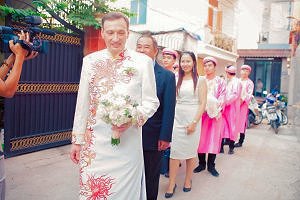
| 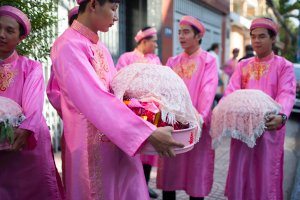 |
| 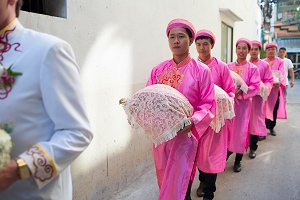 |  | Arrival at the Bride's home and Asking Permission to enter
First
the Groom's Representative enters the bride's family home and a
traditional tea ceremony takes place where the groom's representative
confirms the bride's family's acceptance of the marriage, and asks
permission for the groom to enter the brides house and symbolically the
bride's family.
In the old days this was the last chance for the bride's family to accept or deny the marriage.
|
| Exchange of gifts
The
groom's party presents the groom's gifts to the bride's party outside
of the bride's home, the young women bring the gifts inside to present
the bride's family.
| 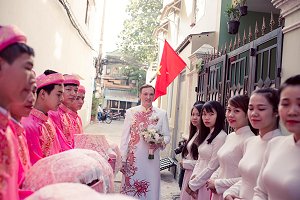 |  |  |  | 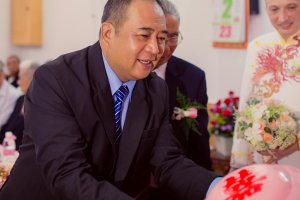 |
| 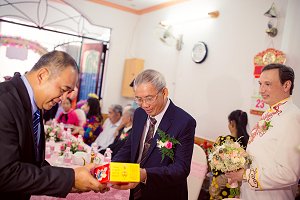 |  | Acceptance of gifts
The
groom's representative presents the gifts to the bride's family, once
the gifts are accepted by the family the father summons the bride.
The
gifts are symbolic and include betel leaves, areca nut fruits (trâ`u,
cau), wine, tea, cheese, cake (ba´nh phu thê) and rice.
| Presenting the Bride
The bride is presented by the bride's mother and the bride is adorned with gold. | 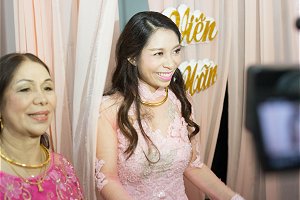 | 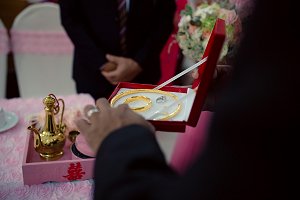 | 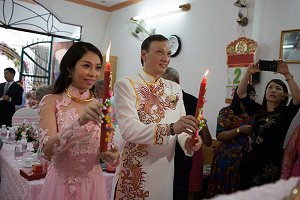 |  | The ceremony
The
wedding ceremony begins in front of the altar. The bride and the groom
pray to the family's ancestors, asking their ancestors' permission to
be married and their blessing on their family-to-be.
| Gifts to the ancestors
The bride and groom then present the gifts to the ancestors. |  | 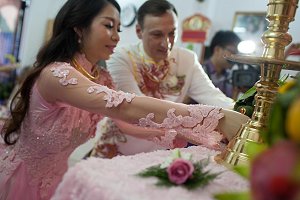 |  | 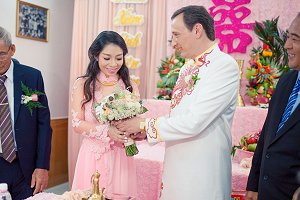 | Thanking the parents of the bride
The couple then turn around and bow to the bride's parents to thank them for raising and protecting her since birth.
The groom then presents the flowers to the bride. | The Marriage
The
bride and groom exchange rings and wedding vows, but the ceremony is not
complete until the bride and groom leave the house with all of the
family's blessings. | 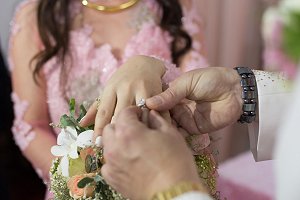 | 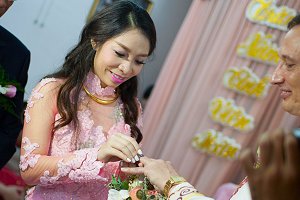 | 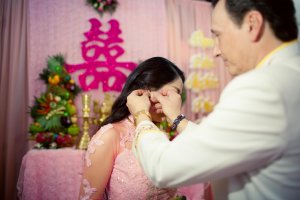 |  | Gifts from the parents
The parents give the newly wedded couple gold bracelets, earrings and other valuable gifts. | Gifts from family and friends
The bride and groom receive gifts of gold or money from the family and friends that attended the ceremony. |  |  | 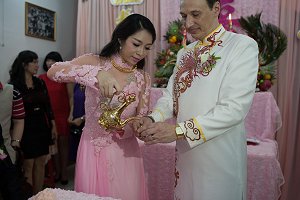
| 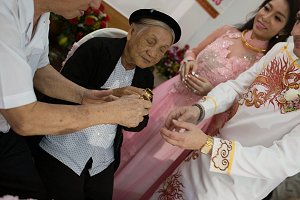 | The Elders blessing
The
bride and groom then serve tea to the elders confirming their blessing
of the marriage and acceptance of the groom as a member of the family.
The elders offer good wishes and words of wisdom for the bride and groom. | The Bride and Groom depart
Once
the bride and groom depart for the groom's home, the wedding ceremony
is complete. Often the two families will then sit down and celebrate
with a meal while the bride goes home with the groom. | 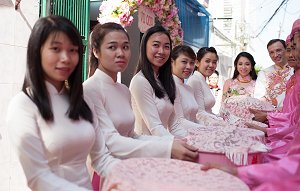 | 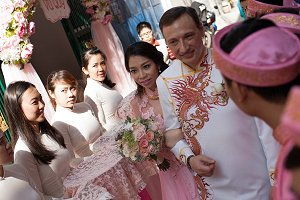 | 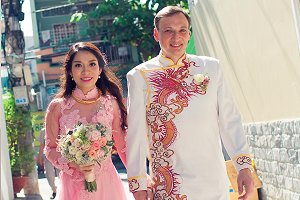 |  | 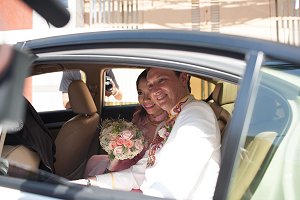 | 
| 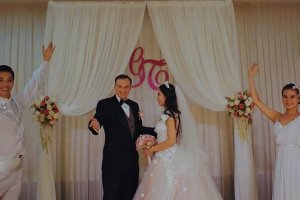 | The Wedding Reception
That
evening the bride's family hosts a formal wedding reception to
officially announce and present the bride and groom as husband and wife
to the community and to friends of the family. | The Vietnamese wedding reception is similar to U.S. wedding receptions with two main differences:
1. More people are invited, we had over 350 guests attend our wedding reception.
2. The pre-wedding photoshoot is displayed as a slideshow at the wedding reception. |  |  |
|
|
|


